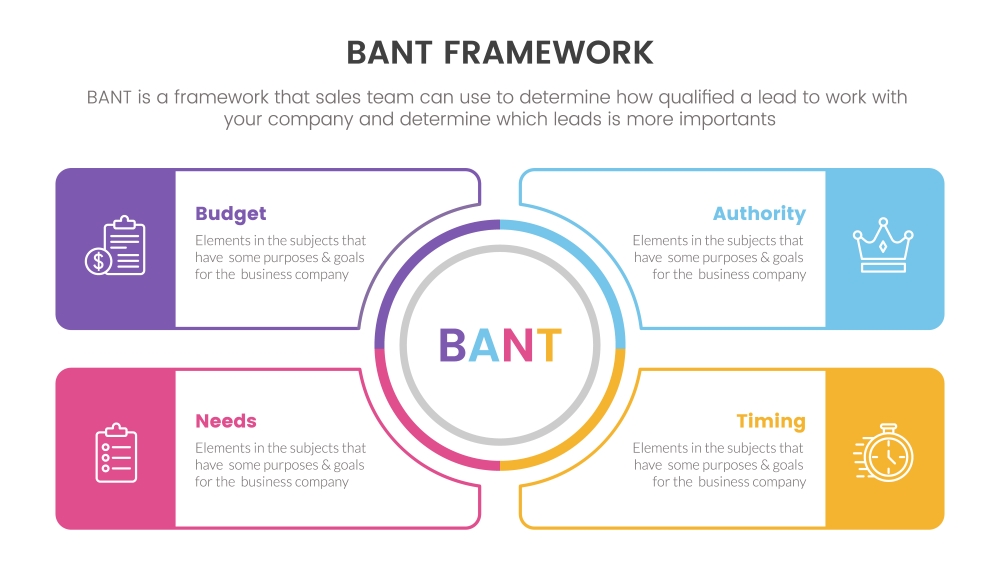Identifying qualified leads is crucial for maximizing your sales efforts. While generating leads is essential, not all leads are created equal. Qualifying them upfront saves you valuable time and resources, allowing you to focus on prospects with high potential to convert.
The BANT framework (Budget, Authority, Need, and Timeline) has long been the foundation of lead qualification. It provides a structured approach to assessing a prospect’s suitability for your product or service. But how do you put BANT into action for B2B lead generation? This guide dives deep into the practical BANT applications, equipping you with actionable tips to transform leads into loyal customers.
We’ll explore each element of BANT in detail, offering strategies for uncovering a prospect’s budget constraints, identifying key decision-makers, pinpointing their specific needs, and understanding their buying timeline.
By the time you finish reading this guide, you’ll have the skills and information necessary to use BANT and other tools to qualify leads with assurance.
Let’s get to know about BANT.
What is BANT?
BANT is an acronym used in sales and marketing to qualify leads based on their Budget, Authority, Need, and Timeline. It helps businesses determine whether a potential customer is likely to make a purchase.
Budget: Can they afford your product or service?
Authority: Who makes buying decisions at this company?
Need: Do they have a problem your product or service can solve?
Timeline: When are they looking to buy something like what you offer?
Businesses that evaluate leads based on these factors can prioritize their efforts and focus on prospects who are most likely to convert into customers.
BANT helps streamline the sales process, ensuring that sales teams invest their time and resources wisely in leads with the highest potential for success.

How do you qualify leads using BANT?
Qualifying leads with BANT involves asking targeted questions and actively listening to the prospect’s responses to assess their fit for your product or service.
Here’s a breakdown of how to use each element:
Budget:
- Questions:
- “What’s your budget allocated for [type of solution you offer]?”
- “Are there budgetary limitations we should consider?”
- Tips: Don’t be afraid to discuss the budget directly. Understanding their constraints helps tailor your pitch and avoid wasting time on prospects who can’t afford your offering.
Authority:
- Questions:
- “Who are the key decision-makers involved in this purchase?”
- “Who will be the primary champion for this project internally?”
- Tips: Identify all decision-makers and understand their roles. This ensures you’re communicating with the right people and addressing any potential concerns they might have.
Need:
- Questions:
- “What are your biggest challenges related to [area your product addresses]?”
- “How would an ideal solution look for you?”
- Tips: Go beyond basic needs identification. Uncover the “why” behind their needs – their deeper motivations and pain points. This allows you to tailor your value proposition to directly address their specific challenges.
Timeline:
- Questions:
- “What’s your timeframe for implementing a solution like ours?”
- “Are there any upcoming deadlines we should be aware of?”
- Tips: Understanding their buying timeline helps you prioritize leads and align your sales cycle with their urgency. This ensures you’re focusing on prospects ready to purchase within your timeframe.
Remember: BANT is a framework, not a rigid script. Adapt your questions and approach based on your specific industry and product/service. By actively listening and uncovering deeper needs, you can effectively qualify leads and close more deals.
What is the BANT framework for qualification?
The BANT framework is a classic sales tool used to qualify potential customers or leads.
Here’s a deeper look at each element:
- Budget: It’s crucial to understand if the prospect’s budget aligns with your product’s pricing. Discussing your budget openly helps avoid wasting time on prospects who can’t afford your offering.
- Authority: Identifying the key decision-makers, sometimes called stakeholders, ensures you’re communicating with the right people. Understanding their roles and concerns helps you tailor your pitch and address any potential roadblocks during the sales process.
- Need: Don’t just focus on surface-level needs. Dig deeper to uncover the “why” behind their challenges. What are the underlying problems your product or service can address? A strong understanding of their specific needs allows you to demonstrate how your offering provides real value.
- Timeline: Knowing the prospect’s buying timeframe helps you prioritize leads and align your sales cycle with their urgency. This ensures you’re focusing your efforts on those most likely to purchase within your timeframe.
While BANT is a valuable tool, it’s important to remember that it’s a framework, not a rigid script. Adapt your questions and approach based on your specific industry, product/service, and individual prospects. By actively listening and uncovering deeper needs, you can effectively qualify leads using BANT and ultimately close more deals.
What strategies do you use to identify and qualify leads?
Businesses can efficiently discover and qualify leads by using focused marketing efforts, lead scoring systems, content marketing initiatives, website analytics, networking, referrals, and social media listening.
Businesses may increase sales and growth by combining these techniques and modifying them depending on success indicators.
Here are a few strategies to look at:
-
Define Your Ideal Customer Profile (ICP):
- This is a detailed profile of your perfect customer, including demographics, firmographics (company size, industry), and buying behaviors.
- Having a clear ICP helps you focus your efforts on attracting and qualifying leads who are most likely to benefit from your product or service.
-
Leverage Lead Generation Techniques:
- Content Marketing: Create valuable content (blogs, articles, white papers) that attract potential customers with relevant interests.
- Social Media Marketing: Use social media platforms like LinkedIn to connect with potential customers and share industry insights.
- Email Marketing: Build an email list of qualified leads and nurture them with targeted content and promotions.
-
Qualification Frameworks:
- BANT (Budget, Authority, Need, Timeline): A classic framework for assessing a lead’s fit based on budget, decision-making power, specific needs, and buying timeframe.
- CHAMP (Challenges, Authority, Money, Priority): Focuses on the prospect’s pain points, key decision-makers, budget, and buying priority.
- MEDDIC (Metrics, Economic Buyer, Decision Process, Pain Points, Implications, and Champion): A more comprehensive framework that goes beyond BANT, considering metrics used to measure success, economic decision-makers, and the internal champion for your solution.
-
Use Lead Scoring:
- Assign points to leads based on their demographics, firmographics, and online behavior.
- Leads with higher scores are considered hotter prospects and prioritized for further engagement.
-
Leverage Technology:
- CRM Systems: Manage and track lead information, interactions, and qualification status.
- Marketing Automation Tools: Automate tasks like email marketing and lead nurturing based on specific criteria.
- Social Listening Tools: Monitor social media conversations to identify potential leads and understand industry trends.
-
Active Listening and Asking Questions:
- Engage your leads in conversations to understand their challenges, goals, and decision-making process.
- Ask insightful questions to uncover their deeper needs and how your solution can address them.
By combining these strategies and adapting them to your specific business, you can develop a robust lead identification and qualification process that helps you attract, engage, and convert high-quality leads into loyal customers.
What is the most important qualification of a bant lead?
The most important qualification of a BANT lead is its readiness to make a purchase. BANT stands for Budget, Authority, Need, and Timeline, and a qualified lead should demonstrate the presence of all these criteria, indicating a genuine interest and ability to move forward in the purchasing process.
Tips for Qualifying Leads and Closing Deals using BANT
Here are some tips for effectively qualifying leads and closing deals using the BANT framework:
- Understand the BANT Criteria: Familiarize yourself with the BANT criteria – Budget, Authority, Need, and Timeline – and ensure that you have a clear understanding of what each entails.
- Ask the Right Questions: Tailor your questions to uncover information related to each aspect of BANT. Ask about budget constraints, decision-making authority, specific needs or pain points, and the timeline for implementation.
- Listen Actively: Pay close attention to the responses provided by the prospect. Listen for cues that indicate their level of interest, urgency, and ability to make a purchase decision.
- Qualify Early: Use BANT as a framework for qualifying leads early in the sales process. This will help you focus your efforts on prospects who are more likely to convert, saving time and resources.
- Address Objections: If any of the BANT criteria are not met initially, work with the prospect to address any concerns or obstacles. Provide relevant information and solutions to alleviate their concerns and move them closer to a purchase decision.
By effectively leveraging the BANT framework, you can streamline your sales process, prioritize qualified leads, and increase your chances of closing deals successfully.
Conclusion
Implementing the BANT framework provides a disciplined way to qualify leads and close deals. Sales professionals can achieve success by prioritizing efforts and adjusting methods based on the prospect’s budget, authority, need, and timetable.
If you are looking for BANT-qualified leads for your businesses, Pangea Global Services is here to help. To learn more, contact us now.






